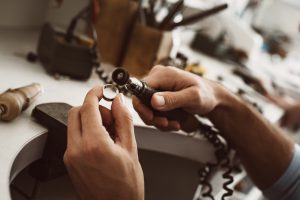Thinking of expanding your service offering? Or are you simply wondering “what is silver-plated jewellery?” and how it differs from sterling silver?
Whether you’re looking to neaten up some old silver jewellery or are stuck between silver-plated and solid silver pieces, we’re here to talk you through the differences – as well as answering questions like “will silver-plated jewellery rust?” and how to keep it looking brand new.
So, what is silver-plated jewellery exactly?
Silver-plated jewellery is made from a thin coating of pure silver over other non-precious metals. Meaning that when the silver scrapes off, you’ll notice the base metal underneath – which is typically brass.
The process was first developed in the 1830s, and is now widely used as it’s low cost and offers many benefits. For example, plating can improve conductivity, prevent corrosion, protect against radiation and can be used to decorate various pieces. Plating can also make a big difference to the price of jewellery, as it’s typically cheaper than solid pieces – which are more expensive because of their purity.
But how long does silver-plated jewellery last? And how do I clean silver-plated jewellery? Find out more below.
Caring for silver-plated jewellery
As you would with any jewellery, caring for silver-plated pieces is extremely important. Wondering “how do I clean silver-plated jewellery?”. Check out our top tips for preventing tarnishing.
Can silver-plated jewellery tarnish?
First up, will silver-plated jewellery rust?
Unfortunately, protecting your silver from tarnishing is practically impossible, as the surface reacts with so many everyday materials. For example, continuous contact with water (chlorine), perfume, hair spray, and so much more, can accelerate the process and cause your silver to turn black. To slow down the effects of tarnishing, follow these simple top tips:
- Clean your jewellery after wearing it. The oils from your skin will collect on the surface of the silver and cause oxidisation.
- Use warm water to gently wash your jewellery on a regular basis, drying it off with a soft cloth.
- Regularly polish your silver, using a polishing cloth at the first sign of tarnishing.
- Don’t wear your jewellery when coming into contact with substances that can cause tarnishing – e.g. while washing up (especially with latex gloves), cooking or in the bath.
- Put on your jewellery after applying make-up and spraying your perfume.
If your silver has already tarnished, you can clean it – but it requires a gentle yet thorough process.
How do I clean silver-plated jewellery?
Because the silver coating is thin, cleaning your jewellery must be approached with care. Follow these easy steps to help your silver-plated jewellery last longer:
- Cover the inside of a bowl with aluminium foil.
- Add 1tbsp baking soda and 1tbsp salt into the bowl and fill it half full of hot water.
- Stir to mix the solution.
- Add in the jewellery so it’s fully covered.
- Leave it to soak for 10 minutes.
- Rinse the jewellery and dry it out with a lint-free cloth.
How to store silver-plated jewellery
Looking for advice on how to store your silver-plated jewellery to help delay tarnishing? Keep it hidden in a place that has limited exposure to air and humidity. For example, store it in sealed bags that can close up tight or keep your silver jewellery close to silica bags which will help to absorb some of the moisture.
What is silver-plated jewellery used for?
When choosing what jewellery to purchase, consider the uses. If you’re planning to wear your pieces every day, then something more solid is more appropriate. But if you’re looking for a ring or necklace that you’ll only wear occasionally, then you might as well opt for plated. Wondering how to tell the difference? Sterling silver will be marked .925, and silver-plated jewellery typically is not.
Making silver-plated jewellery
But what about making your own silver-plated designs? Ideal for smartening up some pre-existing pieces or for creating new designs to expand your service offering, there are a number of techniques for silver plating jewellery. Want to learn more? Check out our guide to silver plating jewellery.
**When using harmful and hazardous materials, be sure to wear gloves and cover work surfaces to protect against stains.**
If you’re thinking of making and selling your own silver-plated jewellery, pick up your silver plating solution and jewellery tools from Cooksongold. If silver plating isn’t for you, check out the equipment and technique focus section of our blog to find some more jewellery making inspiration to help expand your offering and skillset.

Cooksongold


